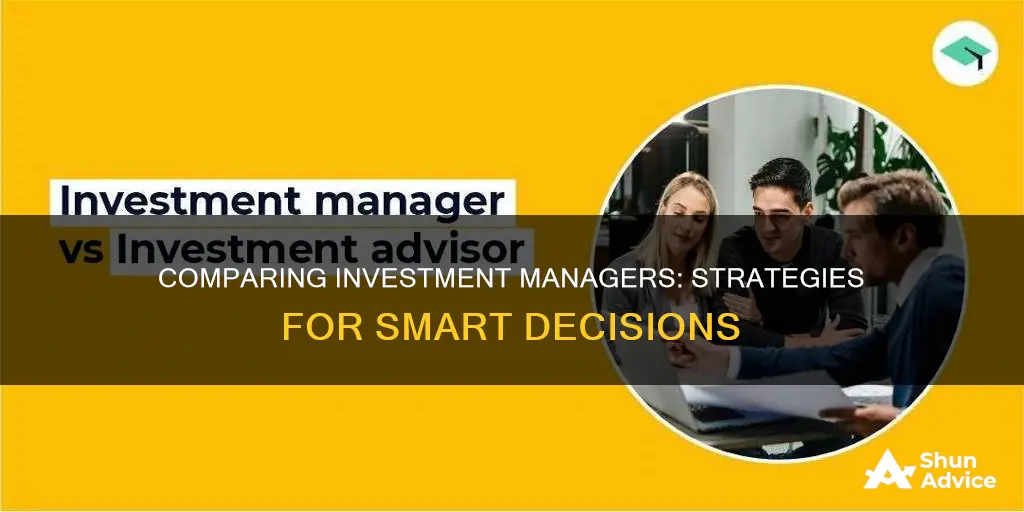
Comparing investment managers is a complex process that requires careful consideration of various factors. Firstly, understanding the investor's needs and goals is essential. This includes clarifying timelines, risk tolerance, investment constraints, and expected returns. Next, conducting initial due diligence involves assessing the manager's philosophy, consistency, longevity, adherence to standards, investment types, fees, and performance. It's crucial to compare managers within the same investment strategy and be cautious about relying solely on past performance. Ongoing due diligence is also necessary, monitoring for changes in the investor's circumstances, the management team, the macroeconomic environment, and the manager's performance. Additionally, investment management fees play a significant role in overall returns, and these should be carefully evaluated. Finally, it's important to remember that quantitative comparisons are just one aspect of the evaluation process, and qualitative factors should also be considered when choosing an investment manager.
What You'll Learn

Investor needs
Before deciding on an investment manager, it is important to understand your investor profile and needs.
If you have complicated future needs for your capital that involve different time horizons, you may need a financial advisor to help you understand how and when you intend to spend your money, and come up with an investment plan that matches the time horizon of your current and future wealth with how you intend to spend it.
If you know what you should do with your investments rationally, but have trouble staying the course when the financial markets move to either extreme, you may need an external voice to get you to adhere to your financial approach consistently, regardless of temptations to deviate.
If you are looking for above-market investment returns, you will need to identify investment managers who will produce superior returns. This is challenging because there is no persistence of results and managers who do well over a 3-year period will not necessarily do any better than average over the next 3 years.
If you want a financial plan but are content with average investment returns, you can find a competent financial planner who will charge you a fair fixed fee and then hand over your money to a reputable low-cost index fund complex.
If you need high-touch service and hand-holding to ease your anxiety about your investments, you can find a financial advisor who will provide you with that. However, you are likely giving up a good chunk of your wealth in the form of fees.
If you are unsure about your ability to manage your money, it is a good idea to find the right financial advisor in an investment company.
Becoming a Financial Investment Manager: The Australian Guide
You may want to see also

Due diligence
Determining the Needs of the Investor
Before evaluating a manager, it's important to understand the investor's needs and goals. This includes considering the time horizon for their goals, the asset classes they want to invest in, any geographical or size constraints, their risk tolerance and volatility expectations, and their income needs. By understanding these factors, you can assess whether a manager has a solid chance of meeting the investor's needs.
Initial Due Diligence
The initial due diligence process involves evaluating a manager's philosophy, process, and performance. It is important to assess whether the manager's philosophy and process align with the investor's needs. Consider the longevity of the management team and their investment process, and whether the manager conforms to Global Investment Performance Standards (GIPS®). Verify the performance of the manager independently and compare their fees relative to their peers. Be cautious when comparing managers with different investment strategies and consider the cyclical nature of markets when evaluating past performance.
Ongoing Due Diligence
Ongoing due diligence involves regularly reviewing the investor's needs and circumstances, as well as monitoring the performance and any changes in the management team or investment process. It is important to establish a timeline and evaluation metrics for dealing with poor performance. Distinguish between acute and chronic underperformance, and be patient and stick to your evaluation process unless there are significant violations or changes.
Manager fees are an important part of the due diligence process. Understand the fee structure of the investment manager and how it compares to their peers. Consider the impact of fees on the overall returns of the investment. Remember that fees are an important factor but should not be the sole criterion for evaluation; the investment process and strategy are also crucial.
Investment Managers' Compensation Strategies in Private Equity
You may want to see also

Investment fees
Types of Investment Fees
Percentage of Assets Under Management (AUM)
A common fee structure is to charge a percentage of the total assets under management. This approach aligns the interests of the investor and the manager, as the manager earns more when the portfolio value increases. The percentage can vary, typically ranging from 0.59% to 1.18% of AUM.
Tiered Fee Structures
Some investment managers offer tiered fee structures, where the percentage fee decreases as the assets under management increase. This structure provides a discount for investors with larger portfolios.
Performance-Based Fees
Performance-based fees, also known as incentive fees, are charged when the investment manager outperforms a predetermined benchmark or return target. While these fees can motivate managers to perform better, they may also encourage excessive risk-taking.
High-Water Mark and Hurdle Rate
To protect investors, some performance-based fee structures include a high-water mark or hurdle rate. A high-water mark ensures that a manager can only charge performance fees after recovering any previous losses. A hurdle rate requires the manager to achieve a minimum return before earning performance fees.
Flat Retainer Fees
Some investment managers charge a flat retainer fee, irrespective of portfolio size or performance. This structure provides predictability and transparency for investors.
Per-Hour Consulting Fees
Investment managers may also charge an hourly rate for specific consulting services, such as financial planning or portfolio analysis.
Commission-Based Fees
Commission-based fees are charged for executing trades or transactions within an investment portfolio. These fees can incentivize frequent trading, which may not always align with the investor's best interests.
Load Fees
Load fees are sales charges associated with buying or selling certain investment products, such as mutual funds. They can be front-end (charged at the time of purchase) or back-end (charged at the time of sale) and can significantly impact the overall cost of an investment.
Hybrid Fee Structures
Some investment managers combine different fee structures, such as asset-based and performance-based fees, to offer a more customized and flexible arrangement for their clients.
Factors Affecting Investment Fees
Types of Investment Vehicles
Mutual fund fees can include management fees, 12b-1 fees (marketing and distribution fees), and load fees. These costs can vary widely among different funds, so it is essential to understand and compare them before investing.
Exchange-Traded Funds (ETFs)
ETFs generally have lower fees than mutual funds due to their passive investment strategy. However, investors should also consider the bid-ask spread and trading commissions when evaluating the total cost of owning an ETF.
Hedge Funds
Hedge fund fees typically include a management fee and a performance fee, which can be quite high due to the complex investment strategies and specialized expertise required.
Separately Managed Accounts (SMAs)
SMAs are customized investment portfolios, and the fees for these services can vary depending on the level of customization and portfolio complexity.
Tips for Evaluating and Comparing Investment Fees
Understanding Fee Structures and Terminology
Investors should familiarize themselves with different fee structures and terminology to make informed decisions.
Analyzing Fee Schedules and Disclosures
Reviewing fee schedules and disclosures, such as Form ADV or mutual fund prospectuses, can help investors compare fees among different investment managers and products.
Asking the Right Questions
Investors should ask potential investment managers about their fee structures, any additional costs, and the services provided for those fees.
Using Online Tools and Resources
Several online tools and resources are available to help investors compare fees and performance, making it easier to identify the most cost-effective options.
Understanding Minimum-Variance Portfolio Investment Proportions
You may want to see also

Risk-adjusted performance
When comparing investment managers, it is important to consider risk-adjusted performance. This involves evaluating the returns generated by an investment relative to the level of risk taken. Here are some key methods and considerations for assessing risk-adjusted performance:
Sharpe Ratio
The Sharpe Ratio is a fundamental concept in finance, particularly in portfolio management. It quantifies the excess return an investment generates relative to its volatility (or risk). The ratio is calculated as follows:
$$\text{Sharpe Ratio} = \frac{R_p - R_f}{\sigma_p}$$
Where:
- \(R_p\) represents the portfolio's average return.
- \(R_f\) is the risk-free rate (e.g. yield on government bonds or Treasury bills).
- \(\sigma_p\) denotes the portfolio's standard deviation (volatility).
A higher Sharpe Ratio indicates better risk-adjusted performance. A positive Sharpe Ratio suggests that the investment has generated excess returns relative to its risk, while a negative Sharpe Ratio implies that the investment underperformed considering the risk taken.
Treynor Ratio
The Treynor ratio is similar to the Sharpe ratio but focuses solely on systematic risk. It measures a portfolio manager's returns in excess of the risk-free rate while also factoring in risk. The formula is as follows:
$$\text{Treynor Ratio} = \frac{Rp - rf}{\beta}$$
Where:
- Rp = Portfolio return
- Rf = Risk-free rate
- Β = Systematic risk
A higher Treynor ratio indicates better performance by the portfolio manager.
Alpha
Alpha measures the excess return on a portfolio over a predetermined benchmark or market index. It reflects how much of the return generated by an investment portfolio is attributed to the portfolio manager's investment decisions. The formula for Alpha is:
Alpha = Portfolio's Absolute Return – Benchmark Return
A positive Alpha indicates that the portfolio manager has outperformed the benchmark, while a negative Alpha suggests underperformance.
Standard Deviation
Standard deviation is a measure of the volatility or variability of returns. It provides insights into the potential range of returns an investment may experience. When assessing risk-adjusted performance, it is important to consider the standard deviation of returns alongside the average return. Investments with lower standard deviation are generally considered less risky.
Beta
Beta measures the sensitivity of an investment's returns to changes in the overall market. A beta of 1 indicates that the investment moves in line with the market, while a beta greater than 1 suggests higher volatility. When evaluating risk-adjusted performance, it is crucial to consider the beta of an investment and its correlation with the market.
Information Ratio
The Information Ratio measures the risk-adjusted return of an investment relative to a benchmark. It helps investors answer two questions: does the active manager outperform the passive benchmark, and can they do so consistently? The formula for the Information Ratio is:
Information Ratio = (Rp – RB)/ σ (p-B)
Where:
- Rp – RB = Excess returns over the benchmark
- Σ (p-B) = Standard deviation of these excess returns, also known as active risk or tracking error
A higher Information Ratio indicates superior risk-adjusted returns compared to the benchmark.
Manager Fees
It is important to consider manager fees when comparing risk-adjusted performance. These fees can impact the overall returns and should be factored into the analysis.
In summary, risk-adjusted performance is a crucial aspect when comparing investment managers. By utilising the above methods and considerations, investors can make more informed decisions by evaluating the returns generated relative to the level of risk taken.
Adjusting Your Child's Future: Editing 529 Investment Portfolio
You may want to see also

Financial advisor options
Financial advisors can be incredibly helpful when it comes to managing your investments and planning for your future. Here are some options and things to consider when choosing a financial advisor:
Online vs In-Person Advisors
Firstly, you'll want to decide whether you want to meet with an advisor virtually or in-person. Online services are typically less expensive and often have lower account minimum requirements, but some people prefer the familiarity and trust that can come with meeting a local advisor face-to-face.
Robo-Advisors vs Financial Advisors
Robo-advisors are digital investment management services that can be a great, low-cost option if you only need help with investment management. However, if you require advice on more advanced topics like estate planning or insurance, you may need a human financial advisor. Financial advisors can develop a relationship with you over time and gain a deeper understanding of your financial needs, but they usually come with higher fees.
Budget and Services
It's important to consider your budget for financial advice and what services you require. Simple, digital-only services will be less expensive, whereas holistic financial planning will cost more. Some advisors charge a flat fee or a percentage of your assets, while others charge around 0.25% of your account balance. Be sure to also factor in any additional costs such as management fees.
Fiduciary Standard
When choosing a financial advisor, it's crucial to select one who follows a fiduciary standard, meaning they are legally required to act in your best interest. Fee-only advisors, who charge flat fees or a percentage of your assets, are less likely to have a conflict of interest than fee-based advisors, who may earn commissions on the products they sell.
Research and Reviews
When researching financial advisors, look for reviews and testimonials from their current or previous clients. Consider the advisor's experience, qualifications, and whether they have a history of successfully helping clients with similar financial goals to your own. It's also essential to ensure they have a good track record of adhering to relevant regulations and standards.
Company-Provided Advisors
If you're employed, your company may offer access to financial advisors as part of your benefits package. These advisors often provide general financial advice and can be a good starting point, especially if you're just beginning your investment journey.
The Emotional Rewards of Saving and Investing
You may want to see also
Frequently asked questions
An investment firm offers professional advice in stocks, bonds, mutual funds, retirement planning, insurance and managing wealth.
Several areas include stocks, bonds, mutual funds, commodities, annuities, real estate, insurance and bank products.
Investors use portfolio diversification to help protect themselves against risk.
A financial planner is a type of financial advisor. Financial advisors are a larger category of individuals who help people manage their finances. A certified financial planner has undergone extensive training, taken an exam, and is legally obligated to act in their client's best interest.
What you look for in a financial advisor will depend on your needs and priorities. Online advisors are generally less expensive, but some people prefer to meet with a local advisor; a familiar face they can come to trust. It might also depend on what you want your advisor to do. For example, if you’re concerned with creating a specific type of portfolio or investing in alternative assets like cryptocurrency, you might prioritize finding an advisor who knows that strategy. But if staying within your budget comes first, and if you’re just starting to build an investment account, it often makes sense to go with a low-fee robo-advisor.







